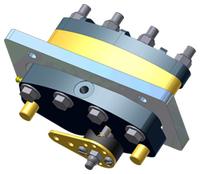
All industrial caliper brakes are made to slow, hold, or stop fast-moving or heavy loads. And they can do it very quickly, if necessary. However, the right type of caliper disc brake depends on the application.
- Heavy-duty off-road vehicles
- utility trucks
- road construction
- turf vehicles
- lift trucks
- aircraft ground support equipment
- military ordnance trailers
- agricultural tractors
- mining equipment
- Industrial applications
- manipulator arms
- hose reels
- web and wire tensioning
- packaging
- printing presses
- CNC machinery
- conveyor belts
- wind energy
- indexers
Finding the Right Brake Size
Brakes have to be powerful enough to do their job, but overkill wastes money. Sizing your brake correctly will ensure ample power and performance without sacrificing cost-effectiveness. You need the right diameter disc as well as the right brake.
To help determine what you need, calculate the braking torque. To do so, use the following equation:
T= W ⋅ K2 ⋅ N ÷ 308t
Where:
- T = Torque, lb⋅ft
- W = Weight of rotating member, lb
- K2 = Radius of gyration of the rotating member, ft.
- N = RPM
- t = Stopping time required, seconds
For more sizing guidance, check out our caliper disc brake sizing guide.
Application Factors to Consider
Size isn’t the only specification to think about when choosing the right caliper disc brake. Depending on your particular application, there are several other factors to consider:
- Operating conditions: Indoors or outdoors, ambient temperature range, and any environmental concerns like exposure to seawater or contaminants.
- Required stop time: Measured in seconds.
- Frequency of stops: Per minute, hour, or day.
- Required torque: Ranging between 600 to 150,000-inch pounds of braking torque.
- Power source: Electric, pneumatic, or hydraulic, which impacts piston seal compatibility.
- Braking needs: Whether you need stopping, holding, or emergency stopping.
- Brake application: On a linear rail or rotor.
- Rotor specifications: RPM, and maximum allowable disc diameter and thickness.
- Energy generation: The amount generated during braking.
By considering these factors, you can choose the caliper brake that is perfectly suited to your application's needs.
Which Caliper Disc Brake Should I Choose?
Mechanical Brakes for Small Wind Turbines
Mechanical brakes operate with a simple lever and require no external power source. Your car’s parking brake is a good example. For industrial purposes, we recommend this style of caliper brake as a safe stopping mechanism for turbine blades on smaller wind turbines in the 5-10kw class.
Pneumatic Brakes to Slow or Stop Rotating or Linear-Moving Parts
Powered by compressed air, pneumatic brakes are common in industrial settings. They operate around 70-120 PSI and are effective for slowing or stopping both rotating and linear-moving parts.
Hydraulic Brakes for Heavy or Fast-Moving Units
Hydraulic brakes use compressed fluid, typically hydraulic oil, and operate at the highest pressures. They are ideal for heavy machinery or fast-moving units, like large wind turbines or mining and oil field equipment. Good examples include large wind turbines and machinery requiring high torque braking, such as mining and oil field equipment.
Pneumatic or Hydraulic Spring Applied Brakes for Emergency Stops
Pneumatic spring applied brakes and hydraulic spring applied brakes use a spring to maintain tension until released by a power source. Known as "fail-safe" brakes, they are essential for emergency stop applications and are common in industrial settings.
Dual-Function Mechanical/Hydraulic Brakes for Higher Torque
Dual-function mechanical/hydraulic brakes combine mechanical and hydraulic power in a single unit, offering an optional energy source and enhanced torque.
Air/oil intensifiers can convert shop air into hydraulic pressure for added flexibility.
At W.C. Branham, we know that brake needs vary by application, which is why we make six different types of industrial caliper brakes.
Despite these choices, we know you still may not find the perfect match. That’s why we can modify any of our standard products to fit your specs, or create custom designs if necessary. We welcome special requests and unusual challenges.


